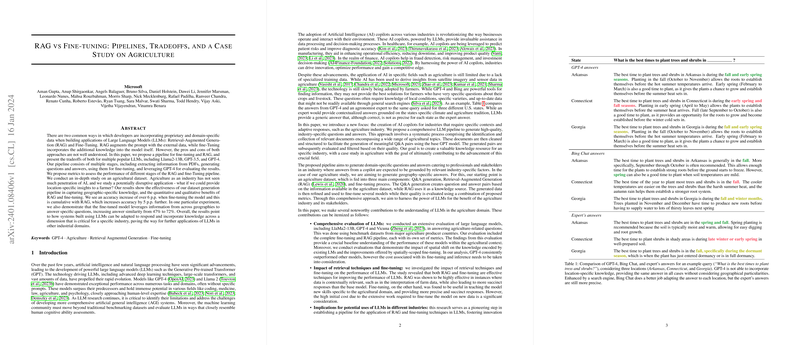Overview of RAG and Fine-Tuning
The utilization of LLMs such as GPT-4 in domain-specific applications involves two primary methods: Retrieval-Augmented Generation (RAG) and fine-tuning. RAG enriches the prompt given to the model with external data, while fine-tuning incorporates additional knowledge directly into the model. This paper outlines a pipeline that combines these methods to improve LLMs' performance in industry-specific contexts, with a particular focus on agriculture.
The Pipeline and Evaluation Metrics
The researchers propose a pipeline that includes stages such as extracting information from PDFs, generating questions and answers, and refining the data for model fine-tuning. The performance of RAG and fine-tuning is assessed using meticulously crafted metrics. These metrics gauge the relevance and quality of questions and answers, as well as the models' ability to incorporate spatially scoped knowledge vital for the examined industry domain.
Fine-Tuning Versus RAG
The paper provides an extensive comparison of the results achieved through RAG and fine-tuning. It highlights the merits and trade-offs of each approach. While RAG is especially advantageous for its low initial costs and improved accuracy by providing contextual relevance, fine-tuning is commended for precise outputs tailored to specific domain knowledge. However, the high initial cost of fine-tuning is acknowledged.
Applications and Future Directions
By illustrating the qualitative and quantitative benefits of both RAG and fine-tuning for different models including GPT-4, the paper paves the way for further applications of LLMs in various industrial segments. It suggests future explorations into how to enhance the structured extraction of document information for the development of knowledgeable AI systems and the potential for multimodal fine-tuning with visuals and text.
The paper concludes that while both RAG and fine-tuning have their specific applications, combining both methods could lead to significant enhancements in LLMs for datasets specific to particular industries. This advancement could extend beyond just agriculture to any domain where specialized knowledge is paramount.
